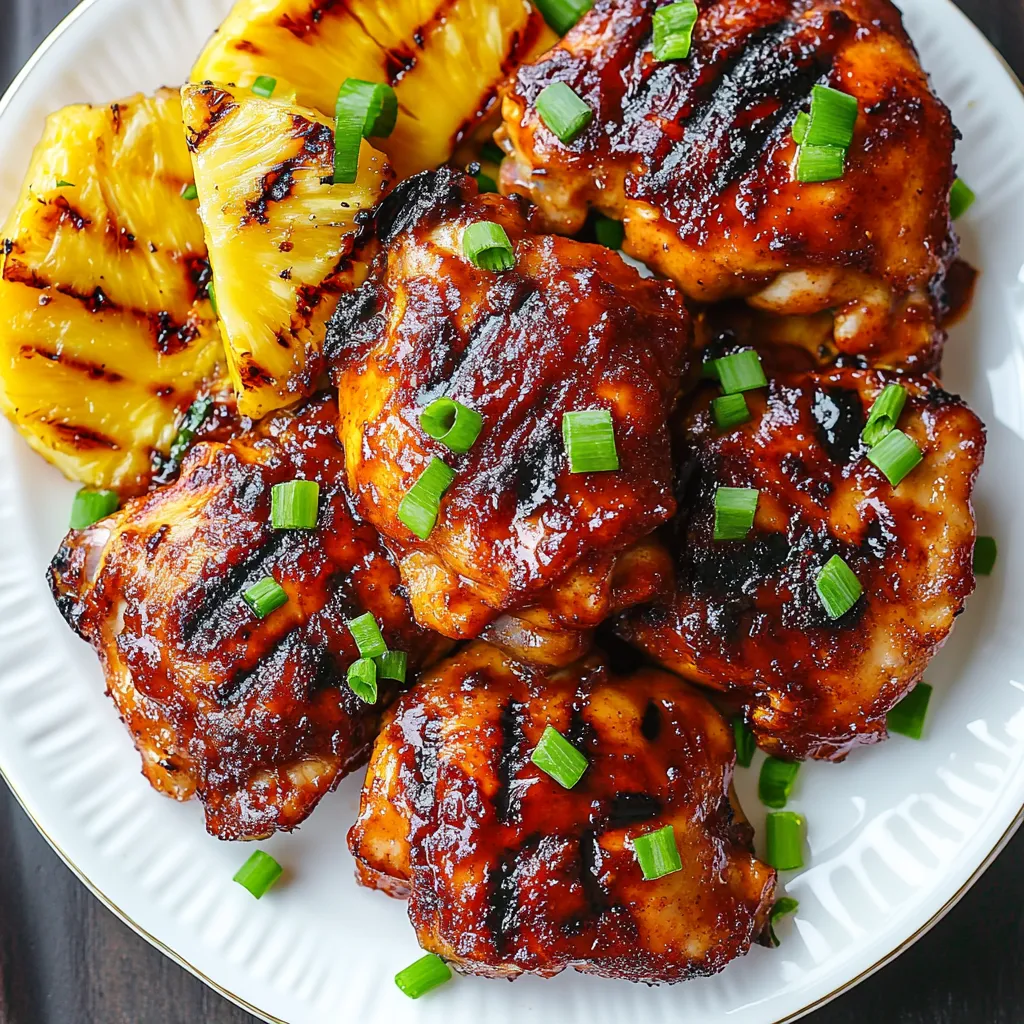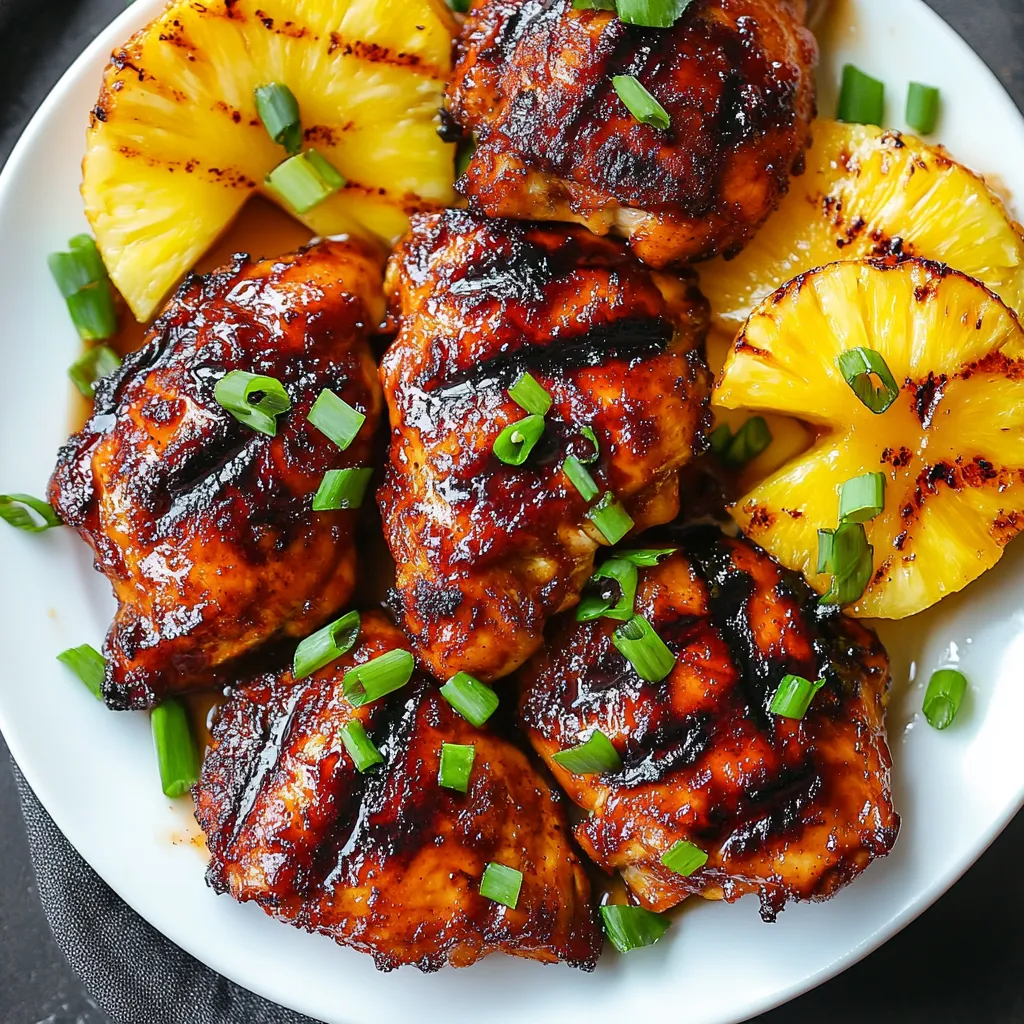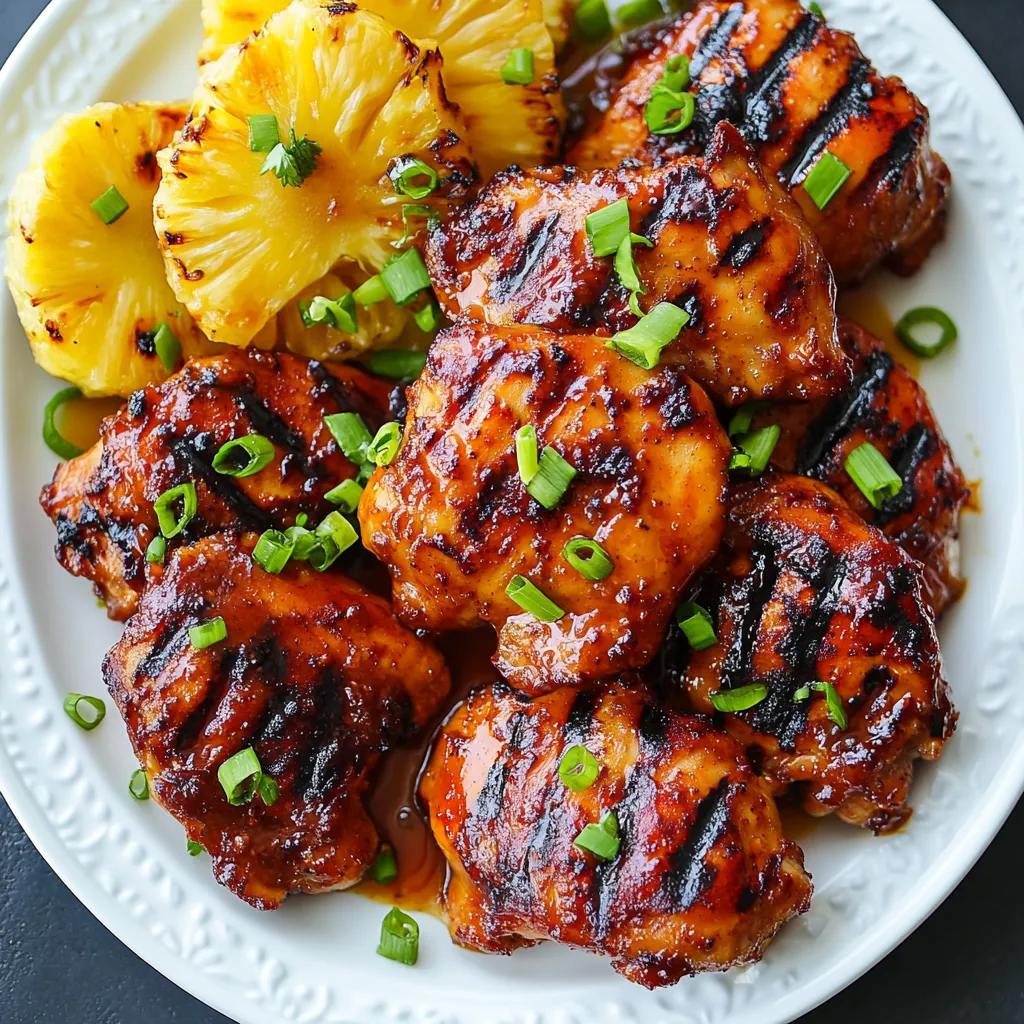 Pin it
Pin it
Marinating chicken in pineapple juice, soy sauce, and brown sugar creates something that tastes like a Hawaiian vacation on a plate. The sweet and savory marinade transforms ordinary chicken into juicy, caramelized pieces with flavors that build with every bite. Grilling the chicken while basting it with reserved marinade develops that characteristic charred exterior and keeps everything moist inside. Serving with grilled pineapple adds fresh tropical sweetness that complements the rich, sticky chicken perfectly. This works beautifully for casual weeknight dinners or impressing guests at summer cookouts.
Hawaiian food became fascinating to me after visiting the islands and tasting real huli huli chicken from a roadside stand. The vendor explained that "huli" means turn, referring to how you keep flipping the chicken while basting it with marinade. When I got home, I recreated those flavors and discovered my family loved this more than any other grilled chicken recipe I'd made. Now we make huge batches for summer parties, and guests always ask what makes it taste so different from regular barbecue chicken. The answer is that pineapple juice marinade working magic overnight.
Ingredients and Why They Matter
- Boneless, skinless chicken thighs: (2-2$ rac{1}{2}$ pounds, about 8 pieces) - Dark meat stays moist and flavorful on the grill; bone-in thighs work but need longer cooking time
- Soy sauce: ($ rac{1}{2}$ cup) - Provides salty umami base that penetrates deeply during marinating; low-sodium works if you want less salt
- Brown sugar: ($ rac{1}{2}$ cup packed) - Adds sweetness that balances soy sauce and helps chicken caramelize beautifully on the grill
- Ketchup: ($ rac{1}{4}$ cup) - Contributes tang, body, and deep red color to the marinade
- Pineapple juice: ($ rac{3}{4}$ cup) - The acidic juice tenderizes chicken while adding tropical sweetness; fresh or canned both work
- Worcestershire sauce: (2 tablespoons) - Adds complexity and depth with its fermented flavor
- Apple cider vinegar: (2 tablespoons) - Brightens everything with acidity that cuts through the sweet and salty elements
- Fresh garlic: (4-5 cloves, minced) - Aromatic punch that infuses chicken with flavor
- Fresh ginger: (1 tablespoon minced) - Brings warm, slightly spicy notes that define Asian-inspired marinades
- Black pepper: (1 teaspoon) - Adds subtle heat and enhances other flavors
- Smoked paprika: (1 teaspoon) - Creates smoky depth even before grilling begins
- Fresh pineapple: (1 whole, cut into rings) - Grilled pineapple develops sweet caramelization that pairs perfectly with the chicken
- Vegetable oil: (for grilling) - Prevents sticking on the grill grates
How To Make It
- Make the marinade and reserve portion:
- Take out a large resealable plastic bag or a large bowl with a cover. In a medium bowl, whisk together the soy sauce, brown sugar, ketchup, pineapple juice, Worcestershire sauce, apple cider vinegar, minced garlic, minced ginger, black pepper, and smoked paprika. Stir everything vigorously until the brown sugar dissolves completely and no lumps remain. The marinade should look smooth and slightly thick from the ketchup. Before adding any chicken, pour about $ rac{1}{2}$ cup of this marinade into a small container with a lid and refrigerate it separately. This reserved portion will be used later for basting while grilling, and keeping it separate from raw chicken prevents cross-contamination. Never baste with marinade that has touched raw meat unless you boil it first.
- Marinate the chicken:
- Add your chicken thighs to the large bag or bowl with the remaining marinade. Seal the bag or cover the bowl and massage or shake everything around until every piece of chicken is completely coated with marinade on all sides. Try to squeeze out as much air as possible from the bag before sealing so the marinade contacts the chicken directly. Place the bag or bowl in the refrigerator and let the chicken marinate for at least 4-6 hours. For absolutely the best flavor, marinate overnight or even up to 48 hours. The longer it sits, the more the flavors penetrate deep into the meat and the more tender it becomes from the acidic pineapple juice breaking down proteins. Turn the bag or stir the bowl once or twice during marinating to ensure even flavor distribution.
- Bring to room temperature:
- About 30 minutes before you plan to grill, remove the marinated chicken from the refrigerator and let it sit at room temperature. This step is important because cold chicken thrown directly onto a hot grill cooks unevenly - the outside burns before the inside reaches safe temperature. Room temperature chicken cooks more evenly and quickly. While the chicken warms up, you can prepare your grill and get the pineapple ready for grilling later.
- Preheat the grill:
- If using an outdoor grill, preheat it to medium-high heat, which is around $375^{\circ} ext{F}$-$400^{\circ} ext{F}$. If using a gas grill, turn all burners to high, close the lid, and let it heat for 10-15 minutes. For charcoal, light your coals and wait until they're covered with white ash before spreading them out. If grilling indoors, heat a grill pan over medium-high heat until a drop of water sizzles immediately. Once your grill is hot, use tongs and a paper towel dipped in vegetable oil to grease the grill grates. This prevents sticking and helps create those beautiful grill marks. Keep your oil and paper towel nearby for re-oiling if needed.
- Start grilling the chicken:
- Remove the chicken thighs from the marinade, letting excess drip back into the bag or bowl. Discard all the marinade that touched raw chicken - don't save it or reuse it. Place the chicken pieces on the preheated grill, laying them flat without crowding. Leave space between each piece for heat circulation and easier flipping. Close the grill lid if using an outdoor grill. Let the chicken cook undisturbed for 6 minutes on the first side. Resist the urge to move or peek at them - that initial sear creates the flavorful crust and grill marks. After 6 minutes, use tongs to flip each piece to the other side. Cook for 3 minutes on this second side.
- Baste and continue grilling:
- Now comes the traditional huli huli technique of flipping and basting repeatedly. Get your reserved marinade that never touched raw chicken. Use a clean brush to generously baste the top surface of each chicken thigh with marinade. Flip the chicken again after another 1-2 minutes and baste the other side. Continue this process of flipping, basting, and cooking for 1-2 minutes at a time. Each flip and baste builds up layers of flavor and helps create that signature sticky, caramelized coating. Total cooking time usually runs 13-15 minutes, though this varies by thickness of the chicken and grill temperature. The chicken is done when an instant-read thermometer inserted into the thickest part reads $165^{\circ} ext{F}$, or when the juices run clear and the meat is no longer pink inside.
- Rest the chicken:
- Once fully cooked, transfer the chicken to a clean plate and tent it loosely with aluminum foil. Let it rest for 10 minutes before serving. This resting period allows juices to redistribute throughout the meat instead of running out when you cut into it. Chicken that rests stays much more juicy than chicken served immediately. Use this resting time to grill your pineapple.
- Grill the pineapple:
- While chicken rests, place pineapple rings directly on the grill grates. Grill for 2-3 minutes per side until you see distinct grill marks and the pineapple starts caramelizing and turning golden at the edges. The natural sugars in pineapple caramelize quickly, so watch carefully to prevent burning. Once grilled on both sides, remove to a serving platter. Arrange the rested chicken pieces alongside the grilled pineapple. Garnish everything with sliced scallions if desired. Serve immediately while still warm, letting everyone grab chicken and pineapple as they want.
 Pin it
Pin it
Chicken thighs became my only choice for grilling after too many dry chicken breast disasters. Even when I occasionally overcook thighs slightly, they stay juicy and flavorful because of their higher fat content. My husband initially resisted dark meat, claiming he only liked white meat, but after one bite of these huli huli thighs, he admitted they were better than any grilled chicken breast he'd ever eaten. Now he specifically requests thighs for all our grilled chicken recipes.
Marinade Chemistry
Understanding what each marinade component does helps you appreciate why this combination works so well. **Soy sauce** provides salt that seasons deeply and umami that creates savory depth. **Brown sugar** adds sweetness and helps proteins caramelize during high-heat cooking. **Pineapple juice** contributes acidity that tenderizes by breaking down tough protein fibers, plus tropical sweetness. **Worcestershire and vinegar** add more acidity and complexity. **Garlic and ginger** bring aromatic flavors that penetrate the meat. Together, these ingredients create balanced flavor that's sweet but not cloying, savory but not salty, with enough acid to brighten everything. The overnight marinating allows all these flavors to meld and penetrate deeply.
Grilling Technique Details
The traditional **huli huli** method of repeatedly flipping and basting creates superior results compared to grilling without turning. Each flip redistributes heat and prevents burning on one side. Each basting adds another layer of caramelized flavor as the sugars in the marinade hit the hot grill surface. The process also keeps the chicken moist by continually adding liquid to the surface. Start with longer cooking time on the first side to establish good sear and grill marks, then switch to shorter intervals for the flipping and basting phase. Using tongs rather than a fork prevents piercing the meat and losing precious juices. Clean tongs between handling raw and cooked chicken to prevent cross-contamination.
Oven Alternative
When grilling isn't possible due to weather or equipment, baking produces delicious results using the same marinade. Preheat your oven to $375^{\circ} ext{F}$ and arrange marinated chicken in a single layer on a rimmed baking sheet. Bake for 20-25 minutes until nearly done, then brush with reserved marinade and add pineapple slices. Switch the oven to **broil on high** and cook for 2-3 minutes, watching constantly, until the chicken caramelizes and chars in spots. The broiler mimics grill heat and creates similar caramelization, though you miss out on that authentic smoky flavor from an outdoor grill. This method works perfectly for winter months when outdoor grilling isn't appealing.
Pineapple Preparation
Fresh pineapple grills better than canned because it's firmer and holds its shape without falling apart. To prepare fresh pineapple, cut off the top and bottom, stand it upright, and slice down the sides to remove the spiky skin. Cut the peeled pineapple into $ rac{1}{2}$-inch thick rounds, then use a small cookie cutter or knife to remove the tough core from each slice. If fresh pineapple isn't available, canned pineapple rings work in a pinch - just drain them very well and pat dry before grilling. The excess moisture on canned pineapple prevents proper caramelization and makes them steam rather than grill.
Serving Suggestions
**Huli huli chicken** pairs beautifully with sides that complement its sweet-savory profile. **Coconut jasmine rice** soaks up the chicken juices and adds tropical notes. Simple steamed white rice works too if you want something more neutral. Grilled vegetables like zucchini, bell peppers, or asparagus add color and nutrition. **Macaroni salad** is traditional Hawaiian plate lunch accompaniment. Fresh green salad with light vinaigrette provides crisp contrast to rich chicken. Coleslaw with Asian-inspired dressing ties flavors together. For complete Hawaiian theme, serve with poi or lomi lomi salmon, though these might be harder to find outside Hawaii.
Storage and Reheating
Leftover huli huli chicken stays delicious for 3-4 days refrigerated in an airtight container. The flavors often taste even better the next day after everything has melded together. Reheat gently to prevent drying out - microwave on medium power for 1-2 minutes, or warm in a $300^{\circ} ext{F}$ oven covered with foil for about 10 minutes. You can also chop leftover chicken and use it in fried rice, grain bowls, salads, or sandwiches. The grilled pineapple keeps for 2-3 days refrigerated and tastes good cold or reheated. Frozen leftovers work too - freeze in portions for up to 3 months, thaw overnight in the fridge, and reheat as above.
 Pin it
Pin it
This Hawaiian huli huli chicken represents the kind of recipe that makes regular weeknight dinners feel special without requiring fancy ingredients or complicated techniques. The overnight marinating fits easily into busy schedules - mix it the night before and tomorrow's dinner is mostly done. When you carry a platter of caramelized, glistening chicken and grilled pineapple to the table and see everyone's faces light up, you know you've made something worth the minimal effort. Sometimes the best recipes are the ones that taste exotic and exciting while being entirely achievable in a regular home kitchen, and this Hawaiian chicken definitely accomplishes that perfectly every single time.
Frequently Asked Questions
- → Can I use chicken breasts instead of thighs?
- Yes, chicken breasts work fine. Just watch the cooking time since breasts cook faster than thighs and can dry out if overcooked.
- → Why can't I use fresh pineapple juice?
- Fresh pineapple has an enzyme that breaks down meat and makes it mushy. Stick with canned or bottled juice for the best texture.
- → How long should I marinate the chicken?
- At least 4 to 6 hours for good flavor, but overnight is even better. You can go up to 48 hours if you want deeper flavor.
- → Can I bake this instead of grilling?
- Absolutely. Bake at 375°F for 30-35 minutes, then brush with marinade and broil with pineapple slices for 2-3 minutes.
- → What does Huli Huli mean?
- Huli means turn in Hawaiian. The name comes from turning the chicken frequently while grilling to get that perfect caramelized coating.
- → Can I make this ahead of time?
- The chicken can marinate for up to 2 days in the fridge. Once cooked, it keeps well for 3-4 days and reheats nicely.
